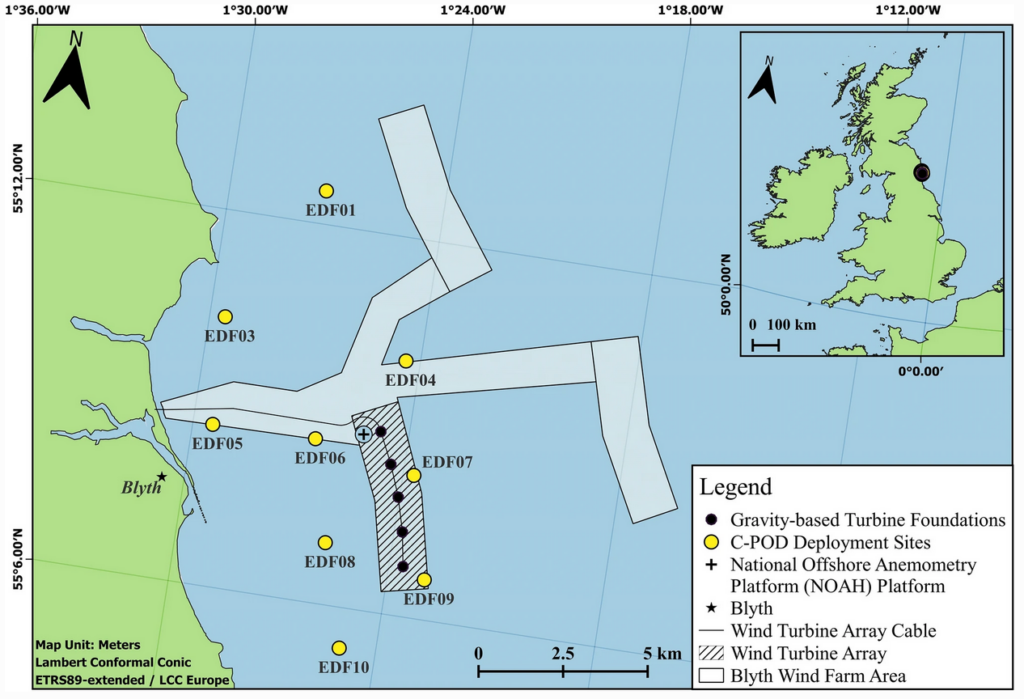Potlock, K.M., Temple, A.J. & Berggren, P. Offshore construction using gravity-base foundations indicates no long-term impacts on dolphins and harbour porpoise. Mar Biol 170, 92 (2023). https://doi.org/10.1007/s00227-023-04240-1
Offshore Wind Energy
As fossil fuels continue to change our planet, the need to switch to renewable resources that are plentiful and reliable is needed now more than ever. Offshore wind has the potential to be one of these resources with more consistent and higher wind speeds over the ocean compared to on land. Offshore wind farms are rapidly expanding to take advantage of this. According to the U.S. Department of Energy’s Offshore Wind Market Report: 2022, the U.S. currently produces 42 megawatts (MW) of power from offshore wind farms. Across the pond, Europe is much more developed with 28.4 GW of power being produced by offshore wind as of mid-2022 (Wind Europe).
As installations continue to grow to meet our power demands, there are concerns over potential negative impacts offshore wind farms will have on local marine life.

Foundation Disturbance

Noise disturbances occur throughout wind turbine installation with the greatest intensity during construction. Anchoring the foundation of the turbine is typically the source, and the severity is dependent on the type of foundation used. Monopile foundations are simple steel rods that are pounded into the seabed by a hydraulic hammer. This can be likened to pounding a nail into a piece of wood. This hammering is feared to be damaging the hearing of local marine mammals, pushing them away from these types of installations. On the other hand, gravity-base foundations utilize gravity to secure themselves to the seafloor. They are pre-constructed concrete structures that resemble cones that are sunk using ballasts filled with water, sand, or gravel. Their drawback is that the seafloor must be flattened out so the foundation sits level on the ground.
Scientists wanted to investigate the effect gravity-base foundations have on local dolphins and harbour porpoise populations compared to monopile foundations. They hypothesized that gravity-base foundations will not disturb local marine mammals as much due to reduced noise disturbance during installation.
Installation and Measurement
This study was conducted in the North Sea, off the coast of Blyth in the United Kingdom. Here, the Blyth Offshore Demonstrator (BOD) project was started in 2016 and came online in 2018 with five offshore wind turbines using gravity-base foundations. Passive acoustic monitoring devices called C-PODS were placed throughout the installation area to record vocalizations of local dolphin and harbour porpoises. Pods frequent this area throughout the year with dolphins residing during the spring and summer and harbour porpoise during the fall and winter, making it the ideal study location.

Animal Activity
Overall, dolphin occurrence did not significantly change throughout the construction and installation of the BOD project. Harbour porpoise on the other hand, increased during and after construction. This could be due to the introduction of a hard structure in a relatively flat and sandy environment, creating a “reef effect.” This occurs when a solid structure provides cover and reduces fishing activity, creating a safe space for small schools of fish which porpoises to feed on.
Prior studies on monopile foundations found construction reduced harbour porpoise populations in the area. Depending on the site, some populations were reported to return while others remained low. This indicates gravity-base foundations are potentially better suited for areas with high marine mammal occurrence. However, further studies are needed to confirm these findings considering the variety of results documented. The importance of a location to these animals and how it is used may be the driving factor between these different outcomes. Breeding grounds and popular feeding areas may draw populations back after a temporary disturbance, whereas casual rest sites can be relocated. Keeping these populations in their natural environment is important to maintain balances in the local ecosystem.
I am a recent MSc graduate in marine biology from Bangor University, where I studied population dynamics of elasmobranchs off the coast of Wales. My interests lie in ecological data analysis to understand environmental processes and identify natural patterns. However, nothing beats being in the field and interacting directly with the marine life.

